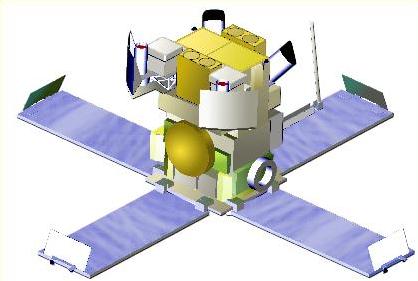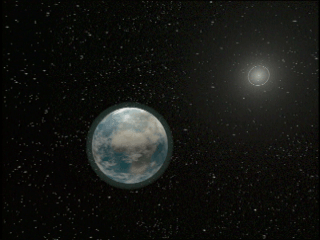Spies a Rare Optical Deep Space
Gamma-Ray Burst Afterglow
 HETE-2 sees gamma-ray burst afterglow in NASA artist concept |
The bursts are like beacons from the early ages of the Universe. They seem to originate billions of lightyears away from where we are, but astronomers aren't sure what causes them or exactly where they originate.
In 2001, NASA's second High Energy Transient Explorer (HETE-2) spacecraft discovered a rare optical afterglow of such a gamma-ray burst (GRB). HETE-2 is the first successful satellite dedicated to detecting and locating these frequent random explosions.
Spreading the news. Seeing the afterglow of a burst is like seeing a cinder slowly fade away. Just seconds after a burst is spotted by the small satellite, it sends the gamma-ray burst's sky coordinates to ground observers who then make detailed observations of the GRB.
The first burst seen by HETE, on Sept. 21, 2001, was located in region of Earth's sky known as the constellation Lacerta. The GRB was relatively close to Earth, at a distance of only five billion lightyears. [ explanation of a lightyear ]
Astronomers, who are trying to figure out what causes them, report that gamma-ray bursts can be more than ten billion lightyears away.
What happened to HETE-1? The concept of a satellite capable of multiwavelength observations of gamma-ray bursts to solve the gamma-ray burst mystery was started in 1989 by NASA as one of its low-cost "University Class" explorers. Design and construction of HETE-1 began in 1992.
HETE-1 satellite was launched November 4, 1996, on a Pegasus rocket from Wallops Island, Virginia. While the Pegasus rocket seemed to achieve a good orbit, its third stage failed to release the satellite. As a result, HETE-1 died due to lack of solar power.
Lightweight and low cost. NASA used spare hardware from the first satellite to construct HETE-2 starting in 1997 at MIT. HETE-2 was built on a small budget equal to only about one-third the cost of a spacecraft in NASA's Small Explorer (SMEX) program. The spacecraft with instruments weighed only 275 lbs.
HETE-2 launch. It was launched to an equatorial orbit on October 9, 2000, on a Pegasus rocket from the Kwajalein Missile Range (KMR) on Kwajalein Atoll in the Republic of the Marshall Islands.
HETE-2 has very fast response time. When it alerts other spacecraft to a gamma ray burst, they are able to point and look in time to see the afterglow of the burst. HETE-2's ability to relay the accurate location of each burst in real-time to optical and radio observatories in space and on the ground is revolutionizing high-energy astrophysics.
 High Energy Transient Explorer is a small science satellite detecting and locating gamma-ray bursts. Coordinates of bursts are sent to ground observers within seconds of detection. HETE's science instruments:
|
HETE found its first burst Sept. 21, 2001. Additional observations of the burst then were made with the Italian BeppoSAX satellite and the Ulysses space probe.
The next day, astronomers armed with the sky location derived from all of the satellite fixes were able to use the Large Format Camera on the Palomar 200-inch telescope in California to see the afterglow in optical light.
Later, on Oct. 17, the astronomers used the Double Spectrograph on the Palomar 200-inch telescope to measure the distant afterglow object's redshift. Also on that day, they used the Very Large Array radiotelescope in Socorro, New Mexico, to pinpoint a twinkling radio signal from the distant object. The event also was recorded 22 hours after the HETE sighting by a robot telescope in Tucson, Arizona.
 NASA artist concept of gamma-ray burst afterglow at a distance from Earth |
The HETE science payload includes a gamma-ray detector and two X-ray detectors. They are sensitive to photons. Sophisticated processing software aboard the satellite allows the location of a burst to be calculated in real time.
HETE instruments also are surveying the X-ray sky. HETE can detect very faint X-ray sources and it is sensitive to flares from X-ray sources in the sky.
HETE was built by MIT and is under NASA's Explorer Program managed by NASA's Goddard Space Flight Center, Greenbelt, Maryland. HETE is a collaboration among NASA; the Massachusetts Institute of Technology (MIT); Los Alamos National Laboratory in New Mexico; France's Centre National d'Etudes Spatiales, Centre d'Etude Spatiale des Rayonnements, and Ecole Nationale Superieure de l'Aeronautique et de l'Espace; and Japan's Institute of Physical and Chemical Research (RIKEN). Science team members are from Brazil, India, Italy, the University of California at Berkeley and at Santa Cruz, and the University of Chicago.
Learn more about HETE:
High Energy Transient Explorer HETE-2
Massachussetts Institute of Technology Center for Space Research
NASA animation of HETE-2 observing gamma-ray bursts
Radioastronomy, Star Formation, and the Interstellar Medium
Small Explorer Program
| Top of this page | More stories | Deep space main page | Space Today Online cover |
Copyright 2000 Space Today Online E-mail.